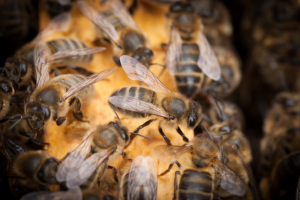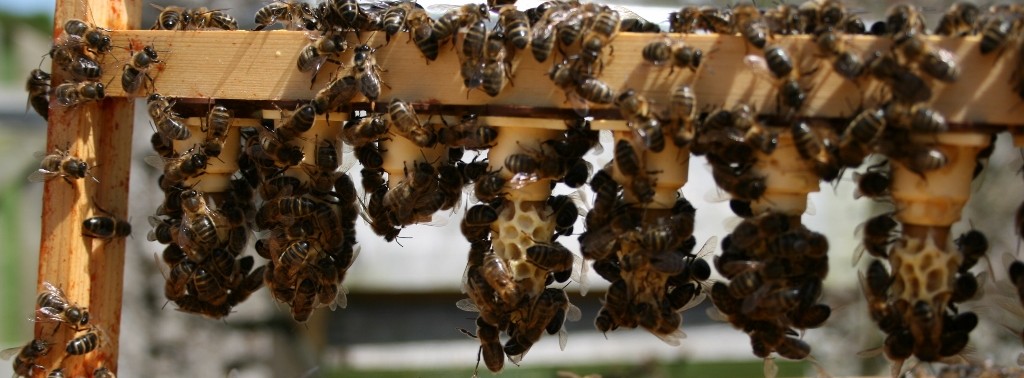So what is a native bee?
A native bee is a bee that has evolved over thousands of years to survive and thrive in a given geographic area. So, for example, the Italian bee – Apis mellifera ligustica is the native Italian bee and it has adapted to the long hot summers and short winters of Italy.
The other 25 sub species of Apis mellifera are each adapted to the specific climatic or vegetational conditions to be found in areas as different to each other as Greece and Russia or Switzerland and Cyprus.
The native Irish bee – Apis mellifera mellifera is a subspecies of the European honey bee which has evolved over thousands of years to thrive in all that the filthy Irish weather can throw at it.

Unfortunately the Irish bee is under threat by imports of bees from other parts of Europe often hybrid Buckfast or Italian bees.
- There is always the risk of bringing in pests (like Small Hive Beetle) and diseases (such as the potentially devastating Fireblight) with the bees. And if you think that can’t happen – how do you think Varroa got here?
- The mating of bees cannot be controlled, so imported bees mate with Irish bees. Subsequent generations are genetically screwed up so any observeable useful traits are no longer heritable in any predictable way.
- Native Irish bees are not aggressive but hybrid bees are;
- Non-native bees and hybrids are less suited to the environment especially when the Irish weather gets rough;
- The importation of even one non-native queen can completely screw up a lifetime’s work. Like mine – she said bitterly.
If the importation of bees was halted today, the characteristics of the native bee would allow it to thrive while the imported strains would eventually fizzle out.
There’s more…
The Latin name for the European Honeybee is Apis mellifera; Apis for ‘bee’ and mellifera for ‘honeybearer’. The species occupies an enormous geographical range extending from Scandinavia and the British Isles in the north, southwards across Europe and into Africa and eastwards all the way to the Urals mountain range which forms a boundary between Europe and Asia.
The best bee for any country, or region within that vast range is the local subspecies. If the reasons for that aren’t obvious to you, here they are:
- The huge geographic area occupied by the European honeybee is far from uniform in terms of temperature, rainfall, wind, altitude and vegetation. Since the last ice age, the friction of natural selection exerted by those factors has caused A.mellifera to evolve into 28 subspecies.
- Each subspecies from the various climatic zones has a different set of features – but they are similar in that they are each perfect for the part of the world where they evolved. Individual races of bees each respond to different triggers – the resulting behaviours are adaptations to local variables and may be inappropriate or even bizarre when expressed elsewhere.
- The hardy subspecies which evolved since the last ice age to colonise the damper and chillier regions of north western Europe is Apis mellifera mellifera.
- The native Irish bee is further evolved to survive and even thrive in the horrible weather we have here. It is genetically distinct from other populations of Apis mellifera mellifera and deserves to be respected and conserved.
It is nonsensical to introduce other subspecies or propagate hybrids of subspecies – this is a pot that does not need stirring. In addition, foreign species bring with them foreign diseases and foreign pests such as Varroa and we all know where that gets us.
The aim of all beekeepers should be to improve their bees but they must be improved within the subspecies, the variety is already there and crossbreeding bees will always eventually result in cross bees or characteristics which are not heritable in any meaningful way.
Characteristics of the Irish Native Bee
- Dark brown, almost black in colour with no amber or yellow rings on the abdomen;
- Quite ‘burly’ in comparison to other races and hybrids – makes it easier to maintain body temperature;
- Narrow bands of sparse dark hair on 3 abdominal segments;
- Longer hairs than A.m.carnica and brown rather than grey;
- Thrifty overwinter with a longer broodless period;
- Slow spring build-up;
- Will work in drizzly weather;
- Tendency to supersede – less risky than swarming in bad climate;
- Small, compact brood nest;
- Short tongue reach – adapted for white rather than red clover;
- Much pollen stored all the way round the brood nest to sustain bees through long spells of shitty weather;
- Very fluid weather-reactive behaviour – will quickly throw out drones midsummer if weather is foul;
- Nosema resistance;
- Apiary vicinity mating – mating can be achieved even in vile weather. There is the risk of in-breeding though.
You’d be lucky to spot that last one but keep your eyes peeled.
The final arbiter is wing morphometry and a Cubital Index of 1.6-1.9.
Click here for Queen Rearing Groups page
Click here for native honey bee improvement
Click here for the Native Irish Honey Bee Society website
Click here for a list of Native Irish Honey Bee Suppliers
Click here to buy the Native Irish Honey Bee book
Copyright © Beespoke.info 2018. All Rights Reserved.

If countries like Australia who didn’t welcome cute little bunnies would shoot airplane passengers the back for forgetting to discard that apple or banana in our suitcase or carry-on, why should we accept foreign bees into this country?
Will the importation of foreign bees stop only when is really IS too late?
Cop on Ireland.
Exactly!
Thank you. A nice explanation of the benefits of using the local bee.
Thanks for a interesting web site
hi there i would like to know if you have any nucs for sale, i had one but i got them late in the year and unfortunately were not strong enough to survive the blast of cold we had a few weeks ago, very disappointed when i inspected the hive today, any help would be greatly appreciated, thanks pat
Shame about your nuc – it’s always tricky getting them through the winter even if they’re very strong with loads of stores there’s always the chance that the queen will fizzle out. They break your heart!
so is it possible for bee’s to eventully be no more in Ireland and if so should the EPA introduce a ban on imported species ?
Hello CivilEngineerDonegal,
In my opinion, yes – there should be a ban on imported species.
For more information on the Irish bee have a look at the Native Irish Honey Bee Society website http://www.nihbs.org